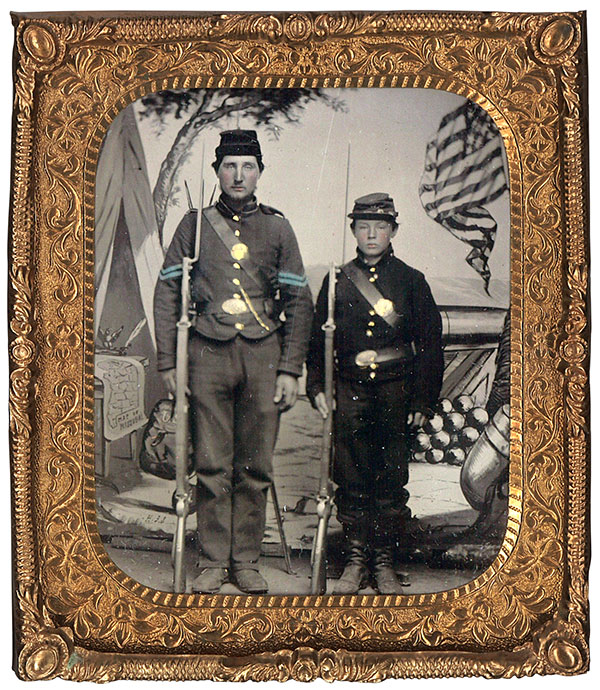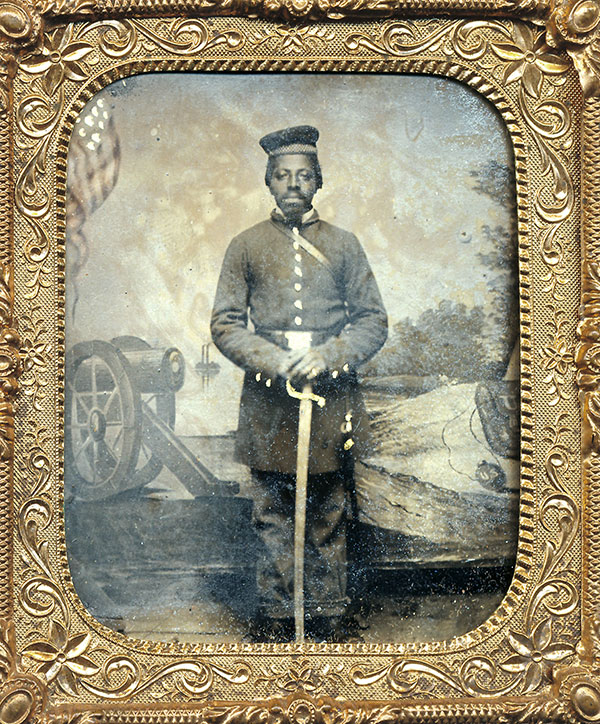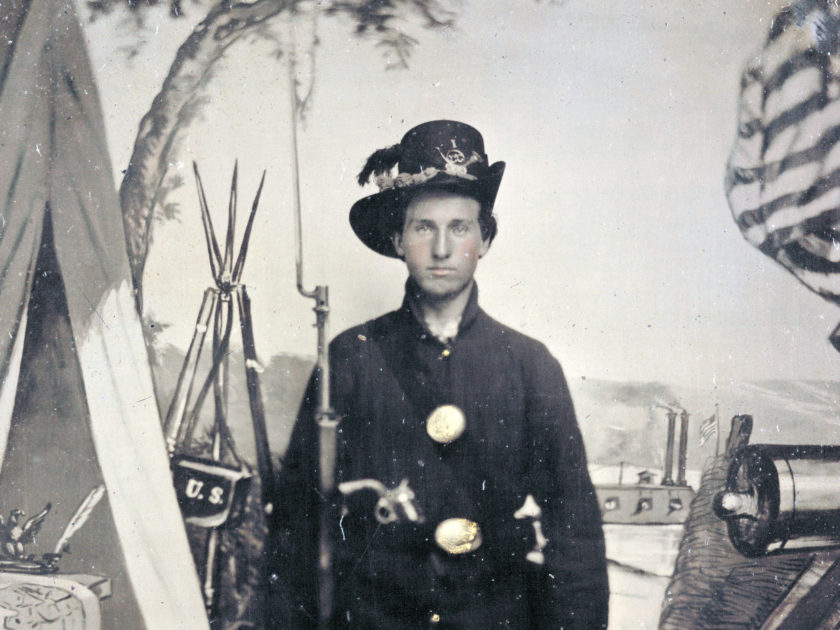By Mike Medhurst and Brian Boeve
Benton Barracks, the bustling Union army’s training facility on the outskirts of St. Louis, was capable of housing up to 30,000 soldiers at one time. Recruits from Missouri and elsewhere poured into the sprawling complex, where they learned the military arts.
Many of these green troops were eager to send home photographs dressed in newly issued uniforms and equipment. And, they did not have to go far.
Photographers lured by the promise of a large clientele of enlisted men and officers and easy money set up studios on the edge of camp. They came from bustling St. Louis, which, with 161,000 inhabitants, was the eighth largest city in the country—less than 500 behind seventh-place Cincinnati and well ahead of ninth place Chicago with 112,000 souls. The size and location of St. Louis attracted an extraordinary assemblage of photographers, and the work they produced rivaled that produced in the larger, established Eastern cities.

Among the most experienced and best known of the lot was Enoch Long (1823-1898). A native of New Hampshire, he had studied in Philadelphia under the guidance of daguerreian pioneer Robert Cornelius. In 1846, Long and his older brother, Horatio, settled in St. Louis and established a national reputation for fine photography. The death of Horatio five years later seemed not to slow down Long. In the Exhibition of the Industry of All Nations held in New York in 1853, examples of Long’s photography were exhibited alongside those of Mathew B. Brady, Marcus Aurelius Root and other masters of the daguerreotype.
Long moved from his gallery in downtown St. Louis to Benton Barracks in 1861. At some point, he commissioned an elaborately painted canvas that symbolically reflected the war in Missouri. The scene features an open tent that reveals a table, upon which lies a state map with county boundaries, a quill pen and inkbottle and an eagle statue. At the foot of the table sit a knapsack and a canteen. Also visible in the foreground is a cannon and stack of ammunition, a stand of muskets and cartridge box, and a section of a defensive work. The Stars and Stripes floats over the patriotic setting, while in the background an ironclad gunboat bellows smoke from its twin stacks, as it steams along the Mississippi River.
The artist who created the backdrop painted the letters “U.S.A.,” “U.S.” and “Map of Missouri” backwards to compensate for ambrotypes and tintypes that appeared in reverse due to technical limitations of the time. The lettering suggests that Long intended the backdrop to be used strictly for these formats. The carte de visite format solved the reversed image issue. Photographs produced in this format by Long’s gallery show the letters reversed. This reinforces his original intent to use the backdrop only for ambrotypes and tintypes.
Today, Long’s backdrop is commonly known as the Benton Barracks Backdrop. It is however, only one of at least six known painted backdrops used by photographers who operated at Benton Barracks.
Long used two other backdrops less commonly seen in his photos. One features a lone cannon and rows of tents in the distance. The other contains many of the same elements found in the Benton Barracks Backdrop, though its most distinguishing characteristic is the gunboat. It is much smaller and less articulated than the vessel found on Long’s popular scene.
Another canvas is easily mistaken for Long’s backdrop at first glance. But a closer examination reveals subtle variations in the map of Missouri, the lettering on the knapsack and cartridge box, the twisted strap on the canteen and the tree. Two larger differences are easier to recognize. The cannon and tent are flipped, and the name of the photographer, “Evans, Artist,” is printed in the lower right. Little is known of Stephen Evans, who operated a studio out of his St. Louis residence from 1864-1865. The similarity between the backdrops suggests that the same artist produced both compositions. Evans may, as the printing on the canvas suggests, be the artist and creator of the backdrops. He may have worked with Long, or perhaps had his own business.
A variation on the Evans backdrop is substantially the same scene, though devoid of trees. Less obvious are subtle differences in the placement and rendering of individual elements.
Perhaps the most familiar backdrop after the Benton Barracks Backdrop is referred to as the “Fort on the Hill Backdrop,” so-called for the prominent structure that dominates the canvas. This backdrop appears in photographs taken by Canadian-born Ansel Ross Butts (1832-1916). Evidence suggests that he relocated from St. Louis sometime in 1864 or early 1865 to a new studio opposite the U.S. Army Quartermaster Department at Benton Barracks. A partner of Long’s at one point, he was not the only photographer with the surname Butts to practice photography at the camp. The other, Chris Butts, is listed as a photographer at Benton Barracks in 1864. Any family relationship between these two photographers is not known.
In addition to the painted backdrops documented here, examples of portraits taken at Benton Barracks with unadorned backdrops exist as well. But no direct evidence supports whether soldiers preferred painted or unadorned backdrops. The choice was likely subjective, and depended upon the personal preferences of the individual.
Yet, the large number of surviving soldier portraits taken at Benton Barracks with the painted backdrops indicates that they were indeed popular.






Mike Medhurst and Brian Boeve are contributing editors to MI.
SPREAD THE WORD: We encourage you to share this story on social media and elsewhere to educate and raise awareness. If you wish to use any image on this page for another purpose, please request permission.
LEARN MORE about Military Images, America’s only magazine dedicated to showcasing, interpreting and preserving Civil War portrait photography.
VISIT OUR STORE to subscribe, renew a subscription, and more.


1 thought on “The Backdrops of Benton Barracks”
Comments are closed.